
Indian locomotive class WAP-5 is a class of electric locomotives used by Indian Railways. The first ten locomotives were imported from ABB in Switzerland in 1995 and later manufactured by Chittaranjan Locomotive Works in India. On 3 July 2014, a WAP-5 set an Indian speed record by hauling a train between Delhi and Agra at a speed of 160 km/h (99 mph). The locomotive has regenerative braking, flexible gear coupling, wheel-mounted disc brakes, and a potential for speed enhancement to 200 km/h (120 mph). Braking systems include 160 kN (36,000 lbf) regenerative brakes, disc brakes, automatic train air brakes and a charged spring parking brake.

The Indian locomotive class WAP-7 is a class of 25 kV AC electric locomotives that was developed in 1999 by Chittaranjan Locomotive Works (CLW) for Indian Railways. The model name stands for broad gauge (W), AC Current (A), Passenger traffic (P) locomotive, 7th generation (7). They entered service in 2000. A total of 1609 WAP-7 have been built, with more units being built at CLW, Banaras Locomotive Works (BLW) and Patiala Locomotive Works (PLW).
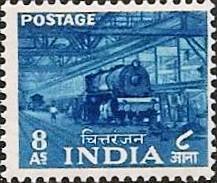
Chittaranjan Locomotive Works (CLW) is an electric locomotive manufacturer based in India. The works are located at Chittaranjan in the Asansol Sadar subdivision of West Bengal, with an ancillary unit in Dankuni. The main unit is 32 km from Asansol and 237 km from Kolkata. CLW has stores and offices in Kolkata, as well as inspection cells in New Delhi, Mumbai, Kolkata, and Bangalore. It is the largest locomotive manufacturer unit in the world, producing 431 locomotives in 2019–20.

The Indian locomotive class WAP-4 is a class of 25 kV AC electric locomotives that was developed in 1993 by Chittaranjan Locomotive Works for Indian Railways. The model name stands for broad gauge (W), AC Current (A), Passenger traffic (P) locomotive, 4th generation (4). They entered service in late 1994. A total of 778 WAP-4 were built at CLW between 1993 and 2015, which made them the most numerous class of mainline electric passenger locomotive until the WAP-7.
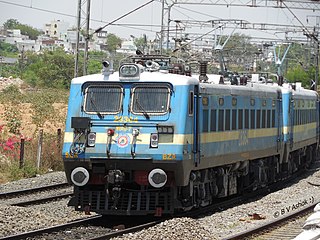
The Indian locomotive class WAG-7 is a class of 25 kV AC electric locomotives that was developed in 1990 by Chittaranjan Locomotive Works for Indian Railways. The model name stands for broad gauge (W), alternating current (A), goods traffic (G) engine, 7th generation (7). They entered service in 1992. A total of 1970 WAG-7 were built at CLW and BHEL between 1990 and 2015, which made them the most numerous class of mainline electric locomotive till its successor the WAG-9.

The Indian locomotive class WAG-5 is a class of 25 kV AC electric locomotives that was developed in 1978 by Chittaranjan Locomotive Works for Indian Railways. The model name stands for broad gauge (W), alternating current (A), goods traffic (G) engine, 5th generation (5). They entered service in 1980. A total of 1196 WAG-5 were built at CLW and BHEL between 1978 and 1998, which made them the most numerous class of mainline electric locomotive till its successor the WAG-7.
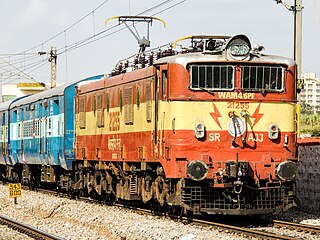
The Indian locomotive class WAM-4 is a class of 25 kV AC electric locomotives that was developed in 1970 by Chittaranjan Locomotive Works for Indian Railways. The model name stands for broad gauge (W), alternating current (A), mixed traffic (M) locomotive, 4th generation (4). They entered service in March 1971. A total of 500 WAM-4 were built at CLW between 1970 and 1983, which made them the most numerous class of mainline electric locomotive till its successor the WAG-5.

The Indian locomotive class WDP-4 is a passenger-hauling diesel-electric locomotive with AC electric transmission designed by General Motors Electro-Motive Division and built by both GM-EMD and under license by Banaras Locomotive Works (BLW) of Varanasi, India for Indian Railways as the classes WDP4, WDP4B and WDP4D. The GT46PAC is a passenger version of the previous Indian Railways EMD GT46MAC freight locomotive. The locomotive has a 16-cylinder 710G3B diesel engine and is one of the fastest diesel-electric locomotives in service in Indian Railways.
The ALCO DL560C is a series of diesel-electric locomotive with AC electric transmission designed by the American Locomotive Company and produced under license by Banaras Locomotive Works (BLW) Varanasi, India for Indian Railways as their classes WDM-2, WDM-3A/2C, WDM-3D and WDG-3A for operation in India. The locomotive is fitted with a 16-cylinder ALCO 251 B,C diesel engine. In the early 1960s Indian Railways needed a reliable diesel workhorse to gradually replace its steam locomotive fleet. Equal numbers of ALCO's DL560C and EMD's G16 were chosen for trials. More locomotives of each of these were purchased for more trials. Indian Railways was keen on producing these locomotives in the country rather than depending on imports. EMD did not agree for a Transfer-of-Technology, while ALCO did. Thus ALCO DL560C was chosen for the job due to its easy maintenance, reliability and simple operation. And from then on vast numbers of this loco in different configurations have been produced and remain the main diesel traction power of Indian Railways.

The HXD2 is an electric locomotive and a series of related locomotive classes built by CNR Datong Electric Locomotive and Alstom. The locomotives designs are based on the Alstom Prima electric locomotives, and are a product of a cooperation agreement signed between the two companies in 2004. All locomotives are intended for heavy freight work, including coal trains on the Datong Qinhuangdao line.
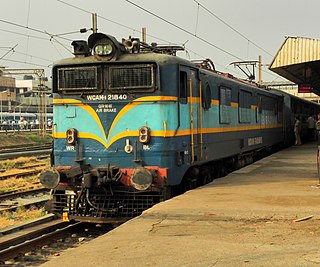
The Indian locomotive class WCAM-1 is a class of Bi-current electric locomotives that was developed in 1973 by Chittaranjan Locomotive Works for Indian Railways. The model name stands for broad gauge (W), DC Current (C), AC Current (A), Mixed traffic (M) locomotive, 1st generation (1). They entered service in March 1973. A total of 53 WCAM-1 were built at CLW between 1973 and 1979, which made them the most numerous class of mainline dual-power AC-DC electric locomotive.

The Indian locomotive class WAG-12B is a class of 25 kV AC electric locomotives that was developed in 2017 by Alstom with technological collaboration with Indian Railways. The model name stands for wide gauge(W), Alternating Current (A), Goods traffic (G) locomotive-12 . They entered trial service in 2019. A total of 370 WAG-12B have been built at Electric Locomotive Factory, Madhepura, Bihar, India.

The Indian locomotive class WCAM–3 is a class of dual-power AC/DC series electric locomotives That was developed in 1997 by Bharat Heavy Electricals Limited used in the Indian Railways system. They are the third locomotives from the WCAM class. The model name stands for broad gauge (W), DC Current (C), AC Current (A), Mixed traffic (M) locomotive, 3rd generation (3). They entered service in 1997. A total of 53 WCAM-3 were built at BHEL between 1997 and 1998, which made them the most numerous class of mainline dual-power AC-DC electric locomotive. They were specifically designed for use by Central Railways in the Ghat section towards Nashik and Pune.
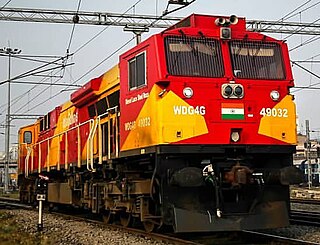
The Indian locomotive class WDG-4G is a class of dual-cabin freight-hauling diesel-electric locomotive used by the Indian Railways (IR). The locomotive is designed by GE Transportation and is based on its Evolution Series, which are used in North America. The class is meant for freight hauling and replaces the older American Locomotive Company (ALCO)-designed locomotives, which have been the mainstay diesels of Indian Railways since 1962. Equipped with a 12-cylinder fully turbocharged GEVO engine, it is claimed to be 50% more environmentally friendly than its predecessors and is the first in the country to be compliant with level one of the emission norms set by the International Union of Railways (UIC-1). The locomotive has two cabs for easy reversal, both of which are air conditioned.

The Indian locomotive class WAP-1 is a class of 25 kV AC electric locomotives that was developed in 1980 by Chittaranjan Locomotive Works for Indian Railways. The model name stands for broad gauge (W), AC Current (A), Passenger traffic (P) locomotive, 1st generation (1). They entered service in late 1981. A total of 65 WAP-1 were built at CLW between 1980 and 1996, which made them the most numerous class of mainline electric passenger locomotive until its successor, the WAP-4.
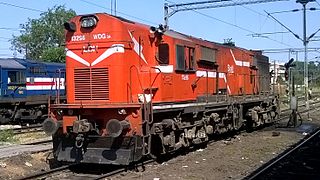
The Indian locomotive class WDG-3A is a class of diesel-electric locomotive that was developed in 1994 by Banaras Locomotive Works (BLW),Varanasi for Indian Railways. The model name stands for broad-gauge (W), Diesel (D), Goods traffic (G) engine, 3,100 hp (3A) locomotive. They entered service on 18 July 1995. A total of 1,164 WDG-3A units were built between 1994 and 2015 at BLW, Varanasi with a few units being produced by Diesel Loco Modernisation Works (DLMW) and Parel Workshop.

The Indian locomotive class WCG-2 is a class of 1.5 kV DC electric locomotives that was developed in the late 1960s by Research Design and Standards Organisation (RDSO) and Chittaranjan Locomotive Works (CLW) for Indian Railways. The model name stands for broad gauge (W), DC Current (C), Goods traffic (G) engine, 2nd generation (2). They entered service in February 1971. A total of 57 WCG-2 were built at CLW between 1978 and 1983, which made them the most numerous class of DC electric locomotive.
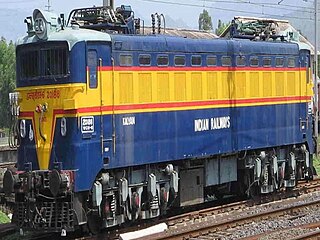
The Indian locomotive class WCM-6 is a class of 1.5 kV DC electric locomotives that was developed in 1995 by Chittaranjan Locomotive Works (CLW) for Indian Railways. The model name stands for broad gauge (W), Direct Current (C), Mixed traffic (M) engine, 6th generation (6). They entered service in 1996. A total of 2 WCM-6 locomotives was built at CLW in 1995. Currently they haul only departmental trains and do shunting duties.

The Indian locomotive class WAG-1 was a class of 25 kV AC electric locomotives that was imported from Europe in the 1960s for Indian Railways. The model name stands for broad gauge (W), AC Current (A), Goods traffic (G) locomotive, 1st generation (1). A total of 112 WAG-1 were built by The European Group 50 Hz Group/European Group/50 Cycles Group (consortium) between 1963 and 1966. They entered service in 1964.

The Indian locomotive class WAG-4 is a class of 25 kV AC electric locomotives that was manufactured by CLW in the late 1960s for Indian Railways. The model name stands for broad gauge (W), AC Current (A), Goods traffic (G) engine, 1st (1). A total of 186 WAG-4 locomotives were built by The European Group 50 Hz Group/European Group/50 Cycles Group (consortium) between 1967 and 1969. They entered service in 1967.
























